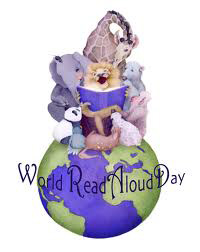 March 6 celebrated World Read Aloud Day but every day is a good day to read aloud to children…or middle schoolers…or a high school class. From beautifully illustrated picture books that can introduce a Shakespearean tragedy to a book of poetry that makes kids laugh or ponder, reading aloud should be a part of today’s reading programs. Reading aloud a chapter book that engages every listener with playful language, or hearing descriptive words that build suspense and create mental images making reading come alive or reading a companion piece of nonfiction that adds real-life drama or historical significance for today, reading aloud builds a reading community.
March 6 celebrated World Read Aloud Day but every day is a good day to read aloud to children…or middle schoolers…or a high school class. From beautifully illustrated picture books that can introduce a Shakespearean tragedy to a book of poetry that makes kids laugh or ponder, reading aloud should be a part of today’s reading programs. Reading aloud a chapter book that engages every listener with playful language, or hearing descriptive words that build suspense and create mental images making reading come alive or reading a companion piece of nonfiction that adds real-life drama or historical significance for today, reading aloud builds a reading community.  This week’s column from the IRA Children’s Literature and Reading SIG encourages teachers who make reading aloud one of their best practices and offer students in their classrooms examples of fluency, vocabulary in context, discussion and response opportunities, listening skills, sheer enjoyment and so much more by the shared experience of hearing a book read aloud.
This week’s column from the IRA Children’s Literature and Reading SIG encourages teachers who make reading aloud one of their best practices and offer students in their classrooms examples of fluency, vocabulary in context, discussion and response opportunities, listening skills, sheer enjoyment and so much more by the shared experience of hearing a book read aloud.
Also see ReadWriteThink's Make the Most of Read Alouds tips and Anita Silvey on World Read Aloud Day on the Engage blog.
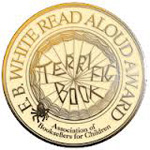
The ABA (American Book Sellers) created the
E.B. White Read Aloud Award in 2004 and expanded in 2006 to create two categories. The winners this past year were:
- Picture Book - I Want My Hat Back by Jon Klassen (Candlewick)
- Middle Grade Readers (a tie) - The Apothecary by Maile Meloy (Putnam) and Wildwood by Colin Meloy (Balzer + Bray)
PRE-SCHOOL (and Easter baskets!)
Boyd, Michele. (2013). Counting bunnies; a creative way to learn numbers, and Mama’s little ducklings. San Diego: Silver Dolphin Books.
Preschool teachers and parents looking for an Easter basket treat will enjoy these two little board books from Michele Boyd. Counting bunnies goes beyond showing pictures of bunnies with the appropriate number but each page prompts with a question to the reader to look for another group of five. This creates a good read aloud for teachers but a great interactive lap book for parents and grandparents. In Mama’s Little Ducklings it turns out one egg is missing. Through lift-the-flap answers, again the interaction between adult and young reader makes this an anticipatory story with very fun illustrations.
- Karen Hildebrand, Ohio Library and Reading Consultant
McPhail, David. (2013). Bella loves Bunny. New York: Abrams Appleseed.
 Fans of Ben Loves Bear (Abrams, 2013) will also adore this sweetly told story in board book form about the bond between a girl named Bella and her stuffed bunny. Best friends, they spend each day together, eating, dressing, playing, and getting ready for bed. From the moment they awaken to the moment they fall asleep, the two of them are inseparable. The first thing Bella does upon awakening is to reach out to Bunny, and they fall asleep holding hands. With its softly-hued illustrations and simple story that will remind older readers of the simple joys of childhood, this one has high appeal for little ones who enjoy the special stuffed animal toys with whom they spend their days.
Fans of Ben Loves Bear (Abrams, 2013) will also adore this sweetly told story in board book form about the bond between a girl named Bella and her stuffed bunny. Best friends, they spend each day together, eating, dressing, playing, and getting ready for bed. From the moment they awaken to the moment they fall asleep, the two of them are inseparable. The first thing Bella does upon awakening is to reach out to Bunny, and they fall asleep holding hands. With its softly-hued illustrations and simple story that will remind older readers of the simple joys of childhood, this one has high appeal for little ones who enjoy the special stuffed animal toys with whom they spend their days.
- Barbara A. Ward, Washington State University Pullman
GRADES K-3
Black, Michael Ian. (2012). I’m bored. Illus. by Debbie Ridpath Ohi. New York: Simon & Schuster Books for Young Readers.
 Sometimes children find themselves at loose ends with nothing to do except complain about how bored they are since they simply cannot find anything with which to occupy themselves. In this picture book a young girl is bored beyond words until she happens upon a potato. Although at first she can't think of anything to do with the spud, she tries desperately to entertain the lackadaisical vegetable. She hauls out all her favorite tricks in an attempt to show him all the neat things the two of them can do with their time, but he remains unimpressed. At first her efforts are simple, for instance, she turns cartwheels, but they gradually escalate into elaborate fantasies in which she fights a dragon. Despite all her efforts, the potato remains unmoved until, to the potato’s great delight, a flamingo arrives on the scene. Turnabout is fair play, though, since the flamingo, too, is bored. The digital illustrations contain just the right colors and images to depict the potato’s blasé personality while also showing the once-bored child working hard to impress him. Young readers and their parents will surely recognize all three of these characters that need merely to find something interesting to do. Reading this title aloud offers readers a chance to turn the pages slowly, savoring their content.
Sometimes children find themselves at loose ends with nothing to do except complain about how bored they are since they simply cannot find anything with which to occupy themselves. In this picture book a young girl is bored beyond words until she happens upon a potato. Although at first she can't think of anything to do with the spud, she tries desperately to entertain the lackadaisical vegetable. She hauls out all her favorite tricks in an attempt to show him all the neat things the two of them can do with their time, but he remains unimpressed. At first her efforts are simple, for instance, she turns cartwheels, but they gradually escalate into elaborate fantasies in which she fights a dragon. Despite all her efforts, the potato remains unmoved until, to the potato’s great delight, a flamingo arrives on the scene. Turnabout is fair play, though, since the flamingo, too, is bored. The digital illustrations contain just the right colors and images to depict the potato’s blasé personality while also showing the once-bored child working hard to impress him. Young readers and their parents will surely recognize all three of these characters that need merely to find something interesting to do. Reading this title aloud offers readers a chance to turn the pages slowly, savoring their content.
- Barbara A. Ward, Washington State University Pullman
Boudreau, Helene. (2013). I dare you not to yawn. Somerville, MA: Candlewick.
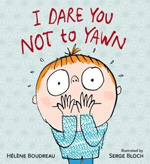 Have you ever tried to stifle a yawn? Author Helene Boudreau has presented a comical look at how to avoid yawning and thus, bedtime. Written almost as a how-to guide NOT to yawn is demonstrated by the main character, a young boy trying to avoid going to bed when he is in the middle of building a great block tower and other fun things. “There you are, minding your own business …” (p.3) “… your arms stretch up, your eyes squish tight, your mouth opens wide, your tongue curls back, and - mmm …rrr…yawrrr – a yawn pops out” (p.4) and the next thing you know your mother has you off to bed! The sounds one makes when yawning or trying to avoid a yawn will make this book a great story time read aloud, especially prior to nap time or for parents at bedtime. Enjoy more background at the author’s website.
Have you ever tried to stifle a yawn? Author Helene Boudreau has presented a comical look at how to avoid yawning and thus, bedtime. Written almost as a how-to guide NOT to yawn is demonstrated by the main character, a young boy trying to avoid going to bed when he is in the middle of building a great block tower and other fun things. “There you are, minding your own business …” (p.3) “… your arms stretch up, your eyes squish tight, your mouth opens wide, your tongue curls back, and - mmm …rrr…yawrrr – a yawn pops out” (p.4) and the next thing you know your mother has you off to bed! The sounds one makes when yawning or trying to avoid a yawn will make this book a great story time read aloud, especially prior to nap time or for parents at bedtime. Enjoy more background at the author’s website.
- Karen Hildebrand, Ohio Library and Reading Consultant
Donaldson, Julia. (2013). The highway rat. Illus. by Axel Scheffler. New York: Scholastic.
 In this rhyming take-off on Alfred Noyes’s classic poem "The Highwayman," a greedy rat masks himself and wreaks havoc on the road, intent on taking everyone's food as he gallops his way through life. His innocent victims can do nothing but give him what he wants, and he collects quite a haul of edibles. But a clever duck finally outsmarts him and lures him to a cave with promises of even more yummy treats from the duck’s sister who lives within the cave. The rat gets his just desserts and ends up wandering through the cave until he takes the perfect job in a cake shop. Meanwhile his victims divide all the food he has secreted in his saddlebags and throw a picnic. The artwork’s bright hues and the text’s rollicking lines allow the animals' personalities to be shine through. This one makes a great choice for reading aloud to others.
In this rhyming take-off on Alfred Noyes’s classic poem "The Highwayman," a greedy rat masks himself and wreaks havoc on the road, intent on taking everyone's food as he gallops his way through life. His innocent victims can do nothing but give him what he wants, and he collects quite a haul of edibles. But a clever duck finally outsmarts him and lures him to a cave with promises of even more yummy treats from the duck’s sister who lives within the cave. The rat gets his just desserts and ends up wandering through the cave until he takes the perfect job in a cake shop. Meanwhile his victims divide all the food he has secreted in his saddlebags and throw a picnic. The artwork’s bright hues and the text’s rollicking lines allow the animals' personalities to be shine through. This one makes a great choice for reading aloud to others.
- Barbara A. Ward, Washington State University Pullman
Falconer, Ian. (2012). Olivia and the fairy princesses. New York: Simon & Schuster/Atheneum.
 That loveable pig Olivia decides that she has had enough with following the trends of others. Fed up with all the pink-tutu-wearing wannabe ballerinas and princesses that surround her, Olivia is determined to remain true to herself. But first, she needs to figure out exactly who she is. Her search for identity leads her down several different paths as she refuses to dress, act or be like the others. Eventually, she does find the proper role for herself, and readers will smile at just how right that choice is. Adults and older readers will hoot at this beloved character’s angst and the two pages that emulate Martha Graham's inimitable dance style while applauding her desire to be true to herself among an increasingly imitative world. The charcoal and gouache illustrations are simply delightful and add to the pleasures of sharing this title aloud with others.
That loveable pig Olivia decides that she has had enough with following the trends of others. Fed up with all the pink-tutu-wearing wannabe ballerinas and princesses that surround her, Olivia is determined to remain true to herself. But first, she needs to figure out exactly who she is. Her search for identity leads her down several different paths as she refuses to dress, act or be like the others. Eventually, she does find the proper role for herself, and readers will smile at just how right that choice is. Adults and older readers will hoot at this beloved character’s angst and the two pages that emulate Martha Graham's inimitable dance style while applauding her desire to be true to herself among an increasingly imitative world. The charcoal and gouache illustrations are simply delightful and add to the pleasures of sharing this title aloud with others.
- Barbara A. Ward, Washington State University Pullman
Helquist, Brett. (2013). Grumpy goat. New York: HarperCollins.
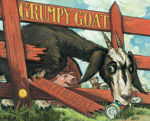 Goat has come to live at Sunny Acres farm and he is one grumpy farm animal! As the other barnyard animals try to befriend Goat, he kicks them away and continues his grumpy solitude. One day as he is munching his way through the garden and then on up the hill, he discovers a lone yellow dandelion shining in the sun. It reminds him of something and so he begins to care for the small flower. As is the way of dandelions, the day comes when it turns to seed and blows away and Goat is once again despondent. However, the farm animals surround him with their concern and friendship. When the dandelions come back into bloom (as dandelions will always do), Goat is ecstatic and in the meantime has learned the power of friendship. Helquist’s illustrations of the barnyard friends depict powerful emotions throughout the story through a variety of facial expressions. Colorful and downloadable activities are available at the publisher’s website. Visit this author/illustrator’s website for background information about his work.
Goat has come to live at Sunny Acres farm and he is one grumpy farm animal! As the other barnyard animals try to befriend Goat, he kicks them away and continues his grumpy solitude. One day as he is munching his way through the garden and then on up the hill, he discovers a lone yellow dandelion shining in the sun. It reminds him of something and so he begins to care for the small flower. As is the way of dandelions, the day comes when it turns to seed and blows away and Goat is once again despondent. However, the farm animals surround him with their concern and friendship. When the dandelions come back into bloom (as dandelions will always do), Goat is ecstatic and in the meantime has learned the power of friendship. Helquist’s illustrations of the barnyard friends depict powerful emotions throughout the story through a variety of facial expressions. Colorful and downloadable activities are available at the publisher’s website. Visit this author/illustrator’s website for background information about his work.
- Karen Hildebrand, Ohio Library and Reading Consultant
Kraegel, Kenneth. (2012). King Arthur’s very great grandson. Somerville, MA: Candlewick.
 Henry, one of the descendants of the mighty King Arthur, sallies forth in search of adventure on his sixth birthday. Determined to prove himself worthy of his namesake, he travels far to challenge a dragon, a cyclops, a griffin, and a leviathan. While all four are monstrous in appearance, each one is mild-mannered in response to his desire to do battle. In fact, the challenges they offer him aren't what Henry expects. For instance, the griffin hunkers over a chessboard, and the cyclops begins a staring contest. Although Henry's quest ends differently than he expected, he finds some unlikely new friends instead of someone to battle and defeat, which is probably the best end to a quest, after all. The watercolor and ink illustrations give depth to the monsters' personalities and Henry’s determined journey. Young readers will enjoy the nifty twist on what they expect to happen in the story.
Henry, one of the descendants of the mighty King Arthur, sallies forth in search of adventure on his sixth birthday. Determined to prove himself worthy of his namesake, he travels far to challenge a dragon, a cyclops, a griffin, and a leviathan. While all four are monstrous in appearance, each one is mild-mannered in response to his desire to do battle. In fact, the challenges they offer him aren't what Henry expects. For instance, the griffin hunkers over a chessboard, and the cyclops begins a staring contest. Although Henry's quest ends differently than he expected, he finds some unlikely new friends instead of someone to battle and defeat, which is probably the best end to a quest, after all. The watercolor and ink illustrations give depth to the monsters' personalities and Henry’s determined journey. Young readers will enjoy the nifty twist on what they expect to happen in the story.
- Barbara A. Ward, Washington State University Pullman
Long, Loren. (2013). Otis and the puppy. New York: Penguin/Philomel.
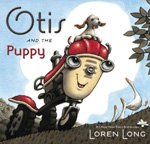 Everyone’s favorite personable tractor, Otis, continues his farm adventures in this sweetly told and vibrantly illustrated tale, perfect for sharing with young readers. With all its many hiding places, the farm is the perfect place to play Hide-and-Seek, and Otis loves playing the game. So does a new addition to the farm, a friendly puppy that seems to love everyone and everything it encounters. But the puppy becomes distracted by whatever it sees while trying to hide, and ends up lost in the woods. Readers will become deeply involved in the story as they wait to see if Otis can overcome his own fear of the dark to help his new friend. The contrasting light and dark illustrations heighten anticipation for what will happen to that puppy and to Otis.
Everyone’s favorite personable tractor, Otis, continues his farm adventures in this sweetly told and vibrantly illustrated tale, perfect for sharing with young readers. With all its many hiding places, the farm is the perfect place to play Hide-and-Seek, and Otis loves playing the game. So does a new addition to the farm, a friendly puppy that seems to love everyone and everything it encounters. But the puppy becomes distracted by whatever it sees while trying to hide, and ends up lost in the woods. Readers will become deeply involved in the story as they wait to see if Otis can overcome his own fear of the dark to help his new friend. The contrasting light and dark illustrations heighten anticipation for what will happen to that puppy and to Otis.
- Barbara A. Ward, Washington State University Pullman
Sayre, April Pulley. (2013). Here come the humpbacks! Illus. by Jamie Hogan. Charlesbridge Publishers.
 Science is for reading aloud, too! Listen to the migrational journey of the humpback whales from their winter home in the Caribbean where a mother whale gives birth to a male humpback calf and then on to the summer feeding ground off the coast of New England. The charcoal and pastel sanded paper illustrations add to the beauty of this story. Readers will learn much about the daily lives and environment of these ocean animals including whale songs and communication, food sources, the birth of a baby whale and also the dangers they face during their migration north from nature and from humans. Visit the author’s website for more background information including her article “Raising a Young Scientist.”
Science is for reading aloud, too! Listen to the migrational journey of the humpback whales from their winter home in the Caribbean where a mother whale gives birth to a male humpback calf and then on to the summer feeding ground off the coast of New England. The charcoal and pastel sanded paper illustrations add to the beauty of this story. Readers will learn much about the daily lives and environment of these ocean animals including whale songs and communication, food sources, the birth of a baby whale and also the dangers they face during their migration north from nature and from humans. Visit the author’s website for more background information including her article “Raising a Young Scientist.”
- Karen Hildebrand, Ohio Library and Reading Consultant
Stein, David Ezra. (2013). Ol’ Mama Squirrel. New York: Nancy Paulsen Books.
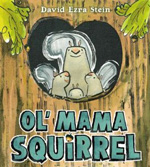 Using the same type of humor and active fun from Interrupting Chicken, author/illustrator David Ezra Stein has produced a laugh out loud read aloud about mother squirrel protecting her nest. Whenever intruders come around including dogs, cats, kites, repairmen and more, mother squirrel lets loose with her barrage of chattering and acorn throwing accompanied by her verbal rebukes, “chook, chook, chook.” One day, however, the intruder proves to be a pretty formidable confrontation in the form of a grizzly bear that invades the squirrels’ tree. Undaunted, mother squirrel not only hops all over the tree with her castigation of the bear’s intrusion, she calls on other neighboring squirrels to help her get rid of this unwanted tree guest. Enjoy videos, interviews and other resources at the author/illustrator’s website. Also enjoy "Putting Books to Work: Interrupting Chicken by David Ezra Stein" on the Engage blog.
Using the same type of humor and active fun from Interrupting Chicken, author/illustrator David Ezra Stein has produced a laugh out loud read aloud about mother squirrel protecting her nest. Whenever intruders come around including dogs, cats, kites, repairmen and more, mother squirrel lets loose with her barrage of chattering and acorn throwing accompanied by her verbal rebukes, “chook, chook, chook.” One day, however, the intruder proves to be a pretty formidable confrontation in the form of a grizzly bear that invades the squirrels’ tree. Undaunted, mother squirrel not only hops all over the tree with her castigation of the bear’s intrusion, she calls on other neighboring squirrels to help her get rid of this unwanted tree guest. Enjoy videos, interviews and other resources at the author/illustrator’s website. Also enjoy "Putting Books to Work: Interrupting Chicken by David Ezra Stein" on the Engage blog.
- Karen Hildebrand, Ohio Library and Reading Consultant
Sutton, Sally. (2013). Farmer John’s Tractor. Illus. by Robyn Belton. Somerville, MA: Candlewick Press.
 Rhyming text and the urgency of impending disaster make a perfect read aloud for young listeners. When the rains start and the river is swelling, it looks like a flood is in the making. With a slight air of anticipation and a question, the repeated phrase, “Farmer John's tractor lies locked in the shed, rusty yet trusty and orangey red” seems to lie in wait for something to happen. Sure enough, a family gets stranded in their little yellow Volkswagen while trying to cross the river and have to climb onto the roof of the car to yell for help. Several vehicles come along to give assistance like a jeep, a tow truck and even a fire engine…but to no avail. When Farmer John sees that nothing is working he jumps into action and hopes that his rusty old tractor will come to life and help these stranded folks out of the river. With a spit and sputter the tractor sparks to life and Farmer John is able to save the family and become the hero of the hour. Grab your students’ interest with this almost wordless book trailer before you start reading aloud. Visit this author from New Zealand at her website.
Rhyming text and the urgency of impending disaster make a perfect read aloud for young listeners. When the rains start and the river is swelling, it looks like a flood is in the making. With a slight air of anticipation and a question, the repeated phrase, “Farmer John's tractor lies locked in the shed, rusty yet trusty and orangey red” seems to lie in wait for something to happen. Sure enough, a family gets stranded in their little yellow Volkswagen while trying to cross the river and have to climb onto the roof of the car to yell for help. Several vehicles come along to give assistance like a jeep, a tow truck and even a fire engine…but to no avail. When Farmer John sees that nothing is working he jumps into action and hopes that his rusty old tractor will come to life and help these stranded folks out of the river. With a spit and sputter the tractor sparks to life and Farmer John is able to save the family and become the hero of the hour. Grab your students’ interest with this almost wordless book trailer before you start reading aloud. Visit this author from New Zealand at her website.
- Karen Hildebrand, Ohio Library and Reading Consultant
Ward, Jennifer. (2013). What will hatch? Illus. by Susie Gharremani. New York: Walker Books for Young Readers/Bloomsbury.
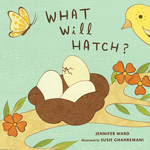 Teachers looking for in introduction to oviparous animals (animals that hatch from eggs) will enjoy reading aloud this science book for young readers. First a little hint: “Sandy ball.” (p.1) Then the recurring questions: “What will hatch?” (p.2) Then the answer: “Paddle and crawl. Sea turtle.” (p.3-4) Using die-cut holes for a little peek into the answers, this pattern continues through the book as readers learn about penguins, tadpoles, crocodiles, robins, caterpillars, and a platypus. The final pages of the book provide factual information about oviparous animals including the gestation period, behavior of the mother, where nests are built, and sibling information. Chicken egg development over a 3-week period is illustrated at the end. A teacher’s guide is available from the publisher.Visit the author’s website and learn how to schedule a Skype visit.
Teachers looking for in introduction to oviparous animals (animals that hatch from eggs) will enjoy reading aloud this science book for young readers. First a little hint: “Sandy ball.” (p.1) Then the recurring questions: “What will hatch?” (p.2) Then the answer: “Paddle and crawl. Sea turtle.” (p.3-4) Using die-cut holes for a little peek into the answers, this pattern continues through the book as readers learn about penguins, tadpoles, crocodiles, robins, caterpillars, and a platypus. The final pages of the book provide factual information about oviparous animals including the gestation period, behavior of the mother, where nests are built, and sibling information. Chicken egg development over a 3-week period is illustrated at the end. A teacher’s guide is available from the publisher.Visit the author’s website and learn how to schedule a Skype visit.
- Karen Hildebrand, Ohio Library and Reading Consultant
GRADES 4-6
Erdrich, Louise. (2012). Chickadee. New York: HarperCollins/Harper.
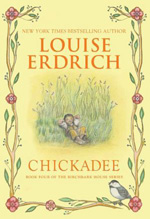 The language is in this book, the fourth title in the Birchbark House series, is mesmerizing, and the author’s ability to tell a simple but memorable tale is surpassed by few. Choosing her words carefully, she slowly reveals her characters, building them and the book's plot deftly and sensitively, gently drawing readers into the family's inner circle, and prompting laughter, weeping, and the breath holding of anticipation to see what happens next. As is the case for all of the author’s books, the story centers around Chickadee and Makoons, the beloved twin sons of Omakayas, a central character in the other books in this series. When two thuggish, slow-witted brothers kidnap Chickadee, he endures several hardships and even a brief, unpleasant encounter with missionaries before finally returning home with his uncle Quill. While Chickadee experiences several trials, including cooking and eating meals from the most repulsive ingredients imaginable for his captors and himself, his Ojibwe family never stops trying to find him, even while his brother Makoons becomes desperately ill. The author never lets readers forget the family ties that bind, and the joy with which each family member is celebrated. Readers are sure to enjoy the complicated ferocity and fierce familial love of Two Strike and the bumbling nature of Chickadee’s captors as well as the strong bond between Chickadee and the natural world.
The language is in this book, the fourth title in the Birchbark House series, is mesmerizing, and the author’s ability to tell a simple but memorable tale is surpassed by few. Choosing her words carefully, she slowly reveals her characters, building them and the book's plot deftly and sensitively, gently drawing readers into the family's inner circle, and prompting laughter, weeping, and the breath holding of anticipation to see what happens next. As is the case for all of the author’s books, the story centers around Chickadee and Makoons, the beloved twin sons of Omakayas, a central character in the other books in this series. When two thuggish, slow-witted brothers kidnap Chickadee, he endures several hardships and even a brief, unpleasant encounter with missionaries before finally returning home with his uncle Quill. While Chickadee experiences several trials, including cooking and eating meals from the most repulsive ingredients imaginable for his captors and himself, his Ojibwe family never stops trying to find him, even while his brother Makoons becomes desperately ill. The author never lets readers forget the family ties that bind, and the joy with which each family member is celebrated. Readers are sure to enjoy the complicated ferocity and fierce familial love of Two Strike and the bumbling nature of Chickadee’s captors as well as the strong bond between Chickadee and the natural world.
- Barbara A. Ward, Washington State University Pullman
Little, Kimberly Griffiths. (2013). When the butterflies came. New York: Scholastic Press.
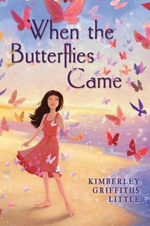 When her beloved scientist grandmother dies, Tara Doucet is left to deal with her extremely depressed mother who hides away in the family’s crumbling Louisiana mansion, a rebellious older sister, Riley, and a mystery left behind by her grandmother. Tara uses each of the ten keys she finds to follow her grandmother’s clues to the island of Chuuk to solve the mystery and somehow save the butterflies her grandmother has been studying. The book has a long list of suspects, a red herring or two, and unexpected twists and turns that force Tara to rely on her own wits. Although Grammy Claire puts her grandchildren's lives at risk, something that few grandparents would do, in the end her reliance on Tara is not misplaced. The beautiful passages describing the butterflies, Grammy’s tree house research lab, and the island will prompt readers to gasp in awe, possibly justifying the risks Grammy takes. Reading this title aloud over several days or nights will allow readers to savor the butterflies’ magic and wonder about the secrets to youthfulness they just may possess. It’s also fun to watch Tara evolve into a much better person.
When her beloved scientist grandmother dies, Tara Doucet is left to deal with her extremely depressed mother who hides away in the family’s crumbling Louisiana mansion, a rebellious older sister, Riley, and a mystery left behind by her grandmother. Tara uses each of the ten keys she finds to follow her grandmother’s clues to the island of Chuuk to solve the mystery and somehow save the butterflies her grandmother has been studying. The book has a long list of suspects, a red herring or two, and unexpected twists and turns that force Tara to rely on her own wits. Although Grammy Claire puts her grandchildren's lives at risk, something that few grandparents would do, in the end her reliance on Tara is not misplaced. The beautiful passages describing the butterflies, Grammy’s tree house research lab, and the island will prompt readers to gasp in awe, possibly justifying the risks Grammy takes. Reading this title aloud over several days or nights will allow readers to savor the butterflies’ magic and wonder about the secrets to youthfulness they just may possess. It’s also fun to watch Tara evolve into a much better person.
- Barbara A. Ward, Washington State University Pullman
Messner, Kate. (2013). Hide and seek. New York: Scholastic Press.
 Fans of Messner’s Capture the Flag (2012) where readers were introduced to the Silver Jaguar Society will welcome this next story about the society’s mysterious activities. José, Anna, and Henry are back as junior members of the Silver Jaguar Society and sworn to protect historical artifacts treasured around the world. Their adventure this time leads them to Costa Rica when they discover the Jaguar Cup, the society’s most valuable artifact, is missing and has been switched with a counterfeit. As the three Americans kids and their families team up with a local Costa Rican boy the trail leads them to an ecolodge in the rain forest. Messner has created an environmental setting where readers will gather not only clues to solve the missing artifact, but learn about the wonders as well as the dangers of the rain forest. This fast-paced historical environmental mystery promises to be an enjoyable addition to the Silver Jaguars fans. Readers who enjoyed the 39 Clues series will find this a suitable next read. Visit Kate’s website for more background, including how to Skype with Kate.
Fans of Messner’s Capture the Flag (2012) where readers were introduced to the Silver Jaguar Society will welcome this next story about the society’s mysterious activities. José, Anna, and Henry are back as junior members of the Silver Jaguar Society and sworn to protect historical artifacts treasured around the world. Their adventure this time leads them to Costa Rica when they discover the Jaguar Cup, the society’s most valuable artifact, is missing and has been switched with a counterfeit. As the three Americans kids and their families team up with a local Costa Rican boy the trail leads them to an ecolodge in the rain forest. Messner has created an environmental setting where readers will gather not only clues to solve the missing artifact, but learn about the wonders as well as the dangers of the rain forest. This fast-paced historical environmental mystery promises to be an enjoyable addition to the Silver Jaguars fans. Readers who enjoyed the 39 Clues series will find this a suitable next read. Visit Kate’s website for more background, including how to Skype with Kate.
- Karen Hildebrand, Ohio Library and Reading Consultant
Pennypacker, Sara. (2013). Clementine and the spring trip. Illus. by Marla Frazee. New York: Disney/Hyperion.
 Class field trips are always a challenge so teachers who are preparing their classes for a spring field trip will enjoy reading Clementine and the spring trip aloud to their classes. Though Clementine normally looks forward to spring especially watching her apple tree begin to bloom, she is getting a little worried about the upcoming school trip to Plimoth Plantation. Clementine’s teacher has announced they would be traveling on Bus Seven, the “cloud.” Bus Seven smells awful “like a stink bomb waiting to explode.” (p.99) Then she learns there are strict rules about making no sounds while you are eating. A classmate named Olive then informs her about speaking Olive Language. When Clementine arrives at Plimoth, better named Plimoth Pebble, she thinks (p.107) they tour the grounds and farm and meet the people in costume acting the part of pilgrims. The scenarios among Clementine and her friends, her principal Mrs. Rice, and her teachers provide a humorous but thoughtful look at life in intermediate school and following all those rules. Read about this author and all the other Clementine books at the author’s website, and check out the activity guide.
Class field trips are always a challenge so teachers who are preparing their classes for a spring field trip will enjoy reading Clementine and the spring trip aloud to their classes. Though Clementine normally looks forward to spring especially watching her apple tree begin to bloom, she is getting a little worried about the upcoming school trip to Plimoth Plantation. Clementine’s teacher has announced they would be traveling on Bus Seven, the “cloud.” Bus Seven smells awful “like a stink bomb waiting to explode.” (p.99) Then she learns there are strict rules about making no sounds while you are eating. A classmate named Olive then informs her about speaking Olive Language. When Clementine arrives at Plimoth, better named Plimoth Pebble, she thinks (p.107) they tour the grounds and farm and meet the people in costume acting the part of pilgrims. The scenarios among Clementine and her friends, her principal Mrs. Rice, and her teachers provide a humorous but thoughtful look at life in intermediate school and following all those rules. Read about this author and all the other Clementine books at the author’s website, and check out the activity guide.
- Karen Hildebrand, Ohio Library and Reading Consultant
GRADES 5-8
Daughtery, James. (2013). Lincoln’s Gettysburg Address; a pictorial interpretation. New York: Albert Whitman & Company.
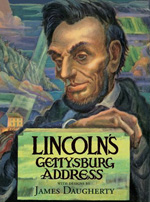 The Common Core State Standards call for looking at primary documents and examining speeches given in the context of the era in which the speaker lived. In the recent award-winning film, Steven Spielberg’s “Lincoln” (DreamWorks, 2012), the opening scene is an emotionally moving scene of The Gettysburg Address delivered by a group of African American Union soldiers. Using this piece as a film clip to introduce the power of this speech might be an interesting way to introduce this book before looking at it page by page. Caldecott Honoree and Newbery Medal winner, James Daugherty, originally published this 2013 edition in 1947. This year marks the 150th anniversary of the famous American speech and has been given a new afterword written by Gabor S. Boritt, a Civil War authority. As teachers and students read through the 15 sentences that comprise this noted speech, Daugherty’s colorful, mural-like illustrations portray an image of life in America at that time. Teachers might like to juxtapose the Michael McCurdy edition of The Gettysburg Address (Houghton Mifflin, 1995) and note the dramatic difference in the style of illustrations. As students observe the pictures and the words and reflect upon the historical era, significant classroom discussions will ensue. The publisher’s website offers a detailed CCSS lesson guide to the use with this beautifully illustrated speech.
The Common Core State Standards call for looking at primary documents and examining speeches given in the context of the era in which the speaker lived. In the recent award-winning film, Steven Spielberg’s “Lincoln” (DreamWorks, 2012), the opening scene is an emotionally moving scene of The Gettysburg Address delivered by a group of African American Union soldiers. Using this piece as a film clip to introduce the power of this speech might be an interesting way to introduce this book before looking at it page by page. Caldecott Honoree and Newbery Medal winner, James Daugherty, originally published this 2013 edition in 1947. This year marks the 150th anniversary of the famous American speech and has been given a new afterword written by Gabor S. Boritt, a Civil War authority. As teachers and students read through the 15 sentences that comprise this noted speech, Daugherty’s colorful, mural-like illustrations portray an image of life in America at that time. Teachers might like to juxtapose the Michael McCurdy edition of The Gettysburg Address (Houghton Mifflin, 1995) and note the dramatic difference in the style of illustrations. As students observe the pictures and the words and reflect upon the historical era, significant classroom discussions will ensue. The publisher’s website offers a detailed CCSS lesson guide to the use with this beautifully illustrated speech.
- Karen Hildebrand, Ohio Library and Reading Consultant
GRADES 8-12
Meyer, L. A. (2012). Viva Jacquelina! Being an account of the further adventures of Jackie Faber, over the hills and far away. New York: Harcourt Children’s Books.
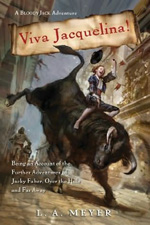 Whether readers are familiar with this book’s heroine from the previous nine books in this series, they will have few problems getting up to speed while falling a little bit in love with Jacky Faber as she goes from adventure to adventure with a dash or two of romance on the side. As she moves from place to place and one set of loving arms after another, she collects many admirers and stories to share. Ah, the stories she will have to tell when things settle down—if they ever do! In this installment of her continuing adventures, the sometime spy travels through Portugal and Spain and ends up preparing paint pigment for the renowned artist Goya who refines her painting techniques and asks that she pose in the nude. She also climbs aboard a bull and races through the city streets during the annual running of the bulls, is hauled in by the Spanish Inquisition, and is befriended by a band of gypsies. Although the author's facility in describing the exotic locales to which Jacky travels is unquestionable, he is also particularly adept at character development. An intriguing woman for the times in which she lives, Jackie is passionate, independent, flirtatious (but only to a certain extent), cocky, determined, and brave. And yet, she remains a virgin and inspires fierce loyalty from those around her. Her zest for life and gently self-deprecating comments in private only serve to endear her to readers. As she comes dangerously close to death time after time, it's difficult to see how she could ever be satisfied with a quiet life at home after all these madcap adventures. Who knows what lies ahead as she sails for America? This is a delightful tale perfect for sharing aloud with others. Just be ready with plenty of tissues, useful to wipe away tears of relief and those from too much laughter.
Whether readers are familiar with this book’s heroine from the previous nine books in this series, they will have few problems getting up to speed while falling a little bit in love with Jacky Faber as she goes from adventure to adventure with a dash or two of romance on the side. As she moves from place to place and one set of loving arms after another, she collects many admirers and stories to share. Ah, the stories she will have to tell when things settle down—if they ever do! In this installment of her continuing adventures, the sometime spy travels through Portugal and Spain and ends up preparing paint pigment for the renowned artist Goya who refines her painting techniques and asks that she pose in the nude. She also climbs aboard a bull and races through the city streets during the annual running of the bulls, is hauled in by the Spanish Inquisition, and is befriended by a band of gypsies. Although the author's facility in describing the exotic locales to which Jacky travels is unquestionable, he is also particularly adept at character development. An intriguing woman for the times in which she lives, Jackie is passionate, independent, flirtatious (but only to a certain extent), cocky, determined, and brave. And yet, she remains a virgin and inspires fierce loyalty from those around her. Her zest for life and gently self-deprecating comments in private only serve to endear her to readers. As she comes dangerously close to death time after time, it's difficult to see how she could ever be satisfied with a quiet life at home after all these madcap adventures. Who knows what lies ahead as she sails for America? This is a delightful tale perfect for sharing aloud with others. Just be ready with plenty of tissues, useful to wipe away tears of relief and those from too much laughter.
- Barbara A. Ward, Washington State University Pullman
These reviews are submitted by members of the International Reading Association's Children's Literature and Reading Special Interest Group (CL/R SIG) and are published weekly on Reading Today Online. The International Reading Association partners with the National Council of Teachers of English and Verizon Thinkfinity to produce ReadWriteThink.org, a website devoted to providing literacy instruction and interactive resources for grades K–12.